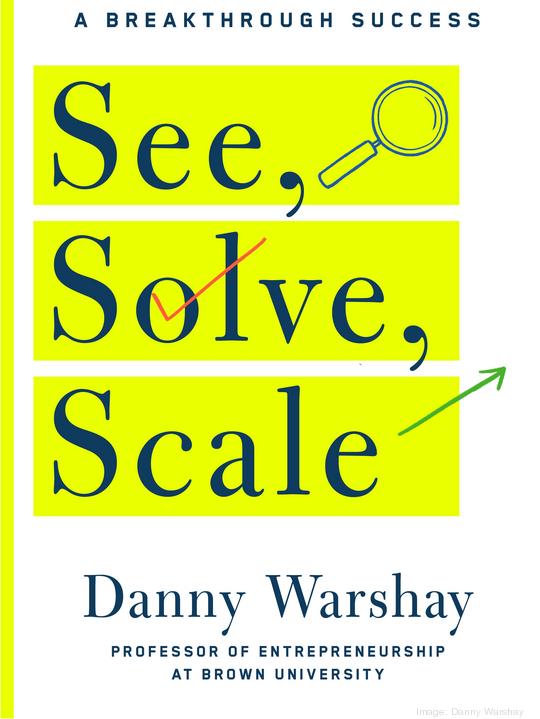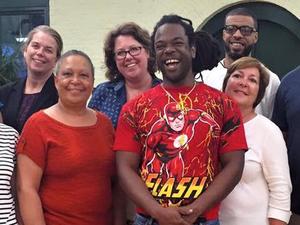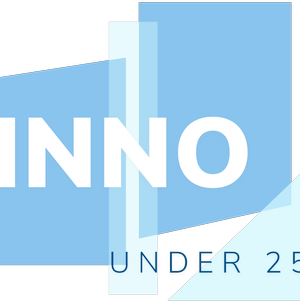
Long before Danny Warshay began teaching students at Brown University how to navigate entrepreneurship, he walked the halls himself trying to find his way in the startup world.
With his new book, “See, Solve, Scale: How Anyone Can Turn an Unsolved Problem Into a Breakthrough Success,” Warshay is taking some of the fundamental lessons from his life experiences and the Brown seminar he teaches and distilling them for people in small, accessible steps.
Warshay got his start in entrepreneurship while an undergraduate at Brown as a member of the Clearview Software leadership team. After Apple acquired Clearview, he co-founded and sold companies in fields ranging from software and advanced materials to consumer products and media. This week, Warshay spoke to Rhode Island Inno about his new book and explained how some of the biggest challenges facing the world could be solved with entrepreneurship.
Warshay said he views entrepreneurship as a liberal arts skill centered around critical thinking and problem solving. As a society, he said, we face problems like food scarcity, illiteracy, inequitable access to education, climate change, pandemics and more that are in dire need of solutions.
The premise of this book is that anyone — not any special type of thinker — can become an entrepreneur and a solver of problems when armed with the right tools, Warshay said. His answers have been lightly edited for brevity and clarity.
For people who may have a cool idea they think could be a business, what should they do next?
Warshay: I define entrepreneurship as a structured process for solving problems. The first step of the See, Solve, Scale process — the most important part by far — is to define the problem you are looking to solve. To find and validate what I call an unmet need. In my teaching at Brown and in workshops around the world, I teach a method of doing this called bottom-up research — a breakthrough anthropological approach that helps entrepreneurs listen and observe to determine what consumers really need, even when consumers themselves do not know. Too often entrepreneurs don't start here, and they rush to create something that risks being a solution in search of a problem.
What are some of the biggest hurdles in entrepreneurship?
Warshay: Mainstream entrepreneurship has ignored, neglected and discriminated against many. Only 2.3% of venture funding goes to women, 1.5% to Latinx founders and 1% to Black founders. These dismal percentages are explained in part by research from my Brown University colleague Banu Ozkazanc-Pan and her coauthor Susan Clark Muntean that concludes an investor is highly likely to rely on stereotypes when deciding who to fund. This approach can and should change.
While far too often sexism, racism and unconscious bias perpetuate these numbers, the hopeful news is that you are more likely to succeed if you recruit diverse team members from beyond your own crowd and beyond your own strong network ties.
Can you talk a little bit about your inspiration for this book?
Warshay: Many of my former students kept telling me how much my teaching had influenced their lives, and they nudged me to write a book to share the process I had taught them along with thousands of other aspiring entrepreneurs. They pointed out that I had followed only the first two steps. I had found and validated an unmet need for aspiring entrepreneurs to learn entrepreneurship. And I had developed a value proposition of teaching a structured entrepreneurial process in the classroom at Brown and in intensive workshops around the world.
What those former students argued to get me off the dime and write this book was that I was not following through on my own process. I was not creating a sustainability model. I wasn’t amplifying that value proposition to have long-term impact at scale. I wasn’t thinking big.
Their clever strategy of using my own teaching persuaded me. It is so nice when the students become the teacher!
What do you see in RI’s future as far as new startups and new growth sectors?
Warshay: As I know from being part of several startups in Rhode Island even since I was a Brown student in the early '80s, our small state is fertile ground for startups of all kinds. Our scale can be an advantage. This relates to a principle I teach in the book that I call the benefits of scarce resources.
At the same time, I welcome affiliation with the Greater Boston entrepreneurship community. Entrepreneurs in Mountain View, California, would never view themselves as "Mountain Viewians." They embrace being part of a Greater Bay Area ecosystem that offers resources and access across a wide range of individual communities.
The same can and should be true for us in Rhode Island. We can help capital and talent resources see that although we are across a state border, we offer wonderful opportunities for investors, talent and other resources to find opportunities here. And likewise, we are less than an hour away from all that Boston offers. Seeing ourselves as part of the same ecosystem can offer a huge advantage to entrepreneurship in both Rhode Island and Massachusetts.








